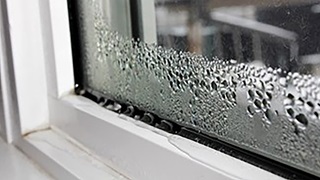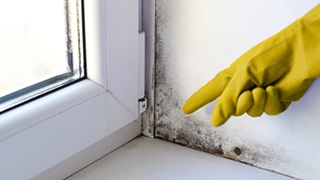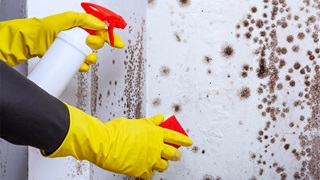
Damp and mould
We take reports of damp and mould very seriously. If you spot signs of damp or mould in your home please report it to us immediately.
How to report damp and mould in your home
Call us on 0300 456 9996.
We’ll ask you what you think is causing the damp or mould, so please see the different types below.
More information about about damp and mould
- What we’ll do to tackle damp and mould
There are lots of reasons that mould and damp can occur in homes. To make sure that every case is investigated we introduced our dedicated Healthy Homes team.
When a case of damp and mould is reported, we prioritise identifying and addressing the root cause of the issue. Our initial step is to diagnose any necessary repairs to resolve the problem at the first point of contact.
Where we cannot diagnose a damp and mould problem, we will send out an L&Q surveyor or contractor to investigate the problem.
During their visit, they will identify the causes of the mould and raise any repairs or remedial works.
While at your home, they may also change your heating controls to help them perform better and work with you to help make changes that will prevent mould in the future.
To help tackle future mould growth, you may be offered a humidity and temperature sensor. The sensor sends alerts to let you know when conditions at your home may encourage mould growth.
You don’t have to have the sensor fitted, but it is advisable to help monitor and manage the issue and help you remain safe and healthy in your home.
Where appropriate, experts will clean any affected surfaces, before shielding them with an anti-mould agent to help prevent them from returning.
- How to avoid damp and mould in your home
- What happens when you report damp and mould
We’ll attempt to diagnose the issue to raise a repair immediately.
If a clear diagnosis cannot be given, we will escalate your case and send an L&Q surveyor or contractor to investigate further.
When an L&Q surveyor or contractor attends an inspection, they will provide us with a report advising on the issue’s severity. The outcome of the report will determine what treatment or repair is required.
Should a repair be advised, the timeframe and duration of the repair will depend on the severity of the issue and this will be discussed with you.
Where appropriate, experts will clean any affected surfaces, before shielding them with an anti-mould agent to help prevent them from returning.
- How we treat damp and mould
Where appropriate, experts will clean any affected surfaces, before shielding them with an anti-mould agent to help prevent them from returning.
Additionally, we'll investigate the root cause of the problem and carry out any repairs needed to tackle this.
We will work with you and provide advice to stop the issue from reoccurring.
There are some simple things you can also do to help avoid this problem appearing in your home.
- Why damp and mould occurs
There are lots of reasons that damp and mould can occur in homes. These can range from too much moisture in the air to plumbing or ventilation faults, or more deep-seated problems with a building.
You should always report damp and mould in your home as soon as possible by contacting our customer service centre. Damp and mould are easier to tackle when it is caught early.
- How to identify condensation, damp and mould
Condensation

Condensation is the result of moisture in the air hitting a cold surface, such as a window or outside wall, and turning back into water.
It’s easiest to see on windows or glass as water droplets, but can also be found on tiles or other cold surfaces.
Damp

Damp comes in two forms:
- penetrating damp (where water comes in from outside)
- rising damp (where water comes up from the ground through the brickwork)
With both kinds, it looks like wet patches on a wall.
Penetrating damp, such as a leak, will look like a tea stain.
Other signs of damp include moss growing on the outside of your brickwork.
Mould

Mould is a type of fungus that grows in damp, moist conditions, and is often the result of condensation or damp.
The longer water stays on surfaces, the more likely it is that mould will grow.
Condensation is the most common cause of mould in the home.
Once you have mould, it can spread easily.
It can grow on most surfaces where moisture is present and may sometimes grow in places you cannot usually see such as behind wallpaper and under carpets.
- Awaab's Law
Together with the rest of the housing sector, we want to make sure that the tragic case of the passing of Awaab Ishak in Rochdale never happens again.
That's why, in line with Awaab's Law which comes into effect at the end of October 2025, we have improved the way in which we deal with your damp and mould reports.
If you report damp or mould in your home, we'll investigate and make your home safe as soon as possible and within the timeframes set out by the new law:
- We will investigate reports of damp and mould within 10 working days and provide you with a written summary of what we’ve found and what we’ll do within three working days of our investigation
- Emergency cases, which may include cases of extensive damp and mould, will be investigated within 24 hours
- We will keep you informed throughout the process
If you find damp and mould in your home, you should report it to us as soon as possible by contacting our customer service centre.
Location set
You can change the location near the bottom of the page